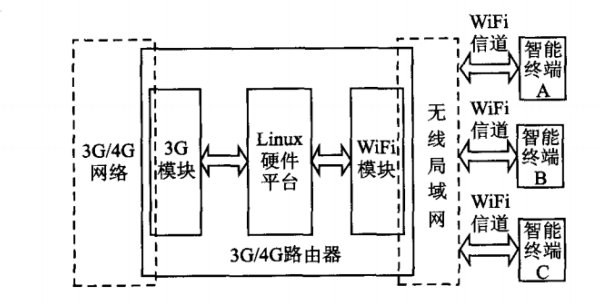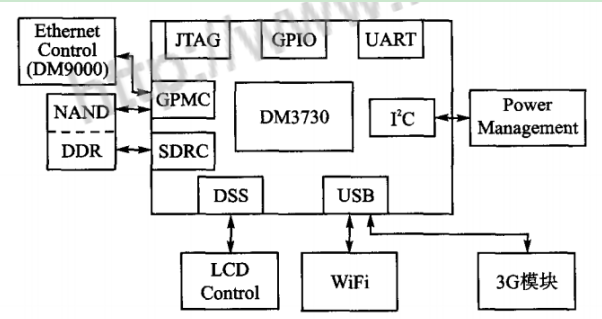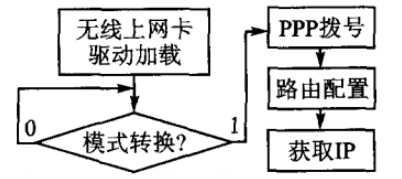The design of this router is based on three modules, namely 3G module, WiFi module and Linux hardware platform, as shown in Figure 1. The function of the 3G module is to use the operator’s wireless data card for PPP dial-up, so that the router can connect to the Internet through the operator’s network. The function of the WiFi module is to make the wireless network card work in AP (AccessPoint) mode and configure the script file of the dynamic host configuration protocol to establish a 2.4GHz WiFi wireless LAN. The function of the Linux hardware platform module mainly has two aspects. On the one hand, it must support the driver of wireless network card and wireless data card. On the other hand, it must connect the wireless LAN and 3G/4G network through the iptables packet filtering system in the embedded Linux system. . Smart terminals and other devices are connected to the wireless LAN provided by the router through the WiFi channel. After being assigned an IP address, data packets are received and sent through the gateway of the wireless LAN, and the gateway uses the 3G/4G module. The network dial-up interface on the router is used to receive and send data packets to the 3G/4G network, thus realizing the design of the router.

The 4G router hardware structure is based on the 3G/4G router design plan. The three major modules of the hardware structure adopt the Devkit8500D evaluation board produced by Shenzhen Tianmo Company, the E392 wireless network card of Huawei Company, and the TL-W N821N type of TP-Link Company. Wireless network card. The basic structure of the Devkit8500D evaluation board is shown in Figure 2. The hardware platform uses TI’s DM3730 microprocessor.

The E392 wireless network card uses Qualcomm’s MDM9x00 multi-mode chipset and supports both TD-SCDMA/WCDMA 3G network standards and LTE-TDD/FDD 4G network standards. Currently, using the upgraded HSPA technology that has been deployed in 3G networks, the downlink peak rate can reach 21Mbps, and the uplink peak rate can reach 5.76Mbps; some areas use 64QAM modulation technology and MIMO technology to upgrade HsPA again, and the downlink peak rate can reach 42Mbps. About; and the 4G network to be deployed, the The peak downlink rate can reach i00Mbps, and the peak uplink rate can reach 50Mbps.
The TL-WN821N wireless network card is designed based on Realtek’s RTL8192cu chip. It adopts MIMO technology and empty channel detection technology, supports 802.11n/b/g, has stable performance and can provide a maximum wireless transmission rate of 300Mbps, fully satisfying the needs of smart terminals. bandwidth requirements of other devices.
4G router key technologies
4G router refers to using the 2.4GHz frequency band of WiFi to establish a wireless LAN, configure the basic information of the wireless LAN, and connect the wireless LAN to the 3G/4G network through iptables of the Linux system. Its key technologies are specifically divided into three parts: 3G/4G network access, wireless LAN construction, and iptables connectivity.
4G network access
The wireless router uses the E392 multi-mode wireless network card to perform PPP dial-up in the embedded Linux system, and is connected to the TD-SCD-MA, WCDMA and TD-LTE experimental networks respectively. It has an implementation flow chart .

Keywords: 4G industrial router